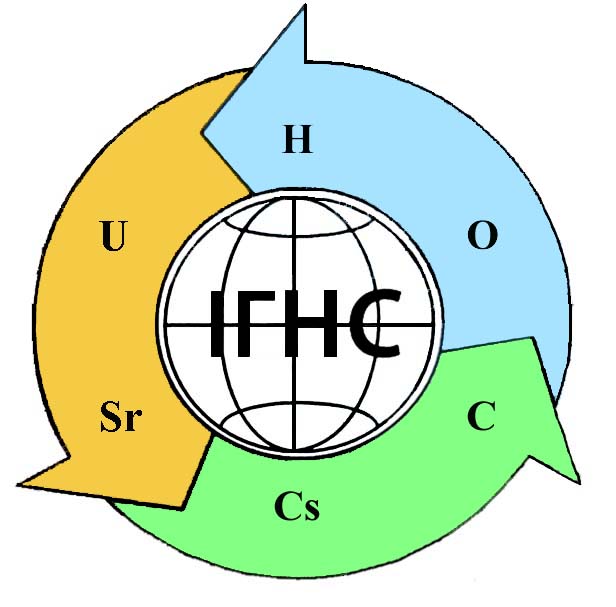GEOCHEMICAL FEATURES OF ADSORPTION OF TRITIUM FROM WATER SOLUTIONS BY CLINOPTILOLITE
Keywords:
clinoptilolite, mineral adsorbent, tritium, tritiated water, thermal processing, fractionation of hydrogen isotopes.Abstract
To study the mechanism of tritium extraction from aqueous solutions of the zeolite, two similar in composition closed stationary experimental systems based on clinoptilolite from the Sokirnytsky deposit (Ukraine) were created. In the first experiment, unchanged natural clinoptilolite was used; in the second, the mineral was thermally treated at 110 °C. The duration of the experiments was about 10 months. Measurements of the specific activity of tritium in the aqueous residue and in the mineral medium made it possible to determine the redistribution of tritium between the solid and liquid phases, as well as between the various structural positions in clinoptilolite. The adsorbed moisture present in the mineral during the interaction of the mineral and aqueous phases initially leads to a partial decrease in the concentration of the tritium indicator in the “HTO”. In the future, this moisture provides the possibility of transit penetration of HTO molecules into clinoptilolite channels due to diffuse molecular exchange of HTO ↔ H2O between the water and mineral phases. Heat treatment reduces the possibility of partial dilution of tritiated water, which interacts with the mineral. Thermal activation of adsorption centers in the mineral mass provides more efficient removal of tritium from the aqueous phase. After heat treatment, the pore space and the surface of the mineral particles are freed from the adsorbed water present in the mineral, and their surface is thermally activated. This leads to a relatively more intensive surface adsorption, where up to 68.5% of tritium absorbed by the mineral accumulates. The interaction of tritiated water with thermally activated surface of mineral particles was accompanied by dynamic adsorption-desorption processes, electrokinetic phenomena in the surface electric layer, which caused the fractionation of hydrogen isotopes with a coefficient α = 1.17. The presence in a heat-treated clinoptilolite of the partial filling of the coordination spheres of alkaline cations, which is similar to the original mineral, made it possible to fractionate hydrogen isotopes in the mineral channels with a coefficient α = 1.16. The heat treatment of clinoptilolite changed the ratio of hydrogen isotopes to hydroxyl groups, where the fractionation coefficient α increased accordingly to 1.06.
References
Гречановская Е. Е. Метрика элементарной ячейки и Si/Al-отношение в цеолитах ряда гейландит-клиноптилолит Сокирницкого месторождения (Закарпатье, Украина) / / Мінералогічний журнал. – 2010. – Т. 32, № 4. – c. 12-22.
Гречановская Е. Е.Микрогетерогенность гейландита-клиноптилолита и её проявление при дегидратации / Гречановская Е. Е., Мельников В. С. // Минералогические музеи. – СпбГУ. – Россия. – Санкт-Петербург. – 2005. – c. 243-244.
Дир У.А., Хауи Р.А., Зусманн Дж. Породообразующие минералы. – М. : Мир, 1966. т.3. – 317 с.
Кукушкин Ю. Н. Лиганды координационных соединений, 1981. Л., 74 c.
Несмеянов Ан. Н. Радиохимия. – М.: Химия, 1972.-591 с.
Поспелов Г. Л. Парадоксы, геолого-физическая сущность и механизмы метасоматоза. «Наука». Новосибирск, 1973. – 355 с.
Пушкарьов О.В., Приймаченко В.М. Взаємодія тритієвої води з глинистими мінералами. //Збірник наукових праць/ Інститут геохімії навколишнього середовища – Київ, 2010. – вип..18. c.–149-156.
Тарасевич Ю. И. Адсорбция на глинистых минералах. / Ю.И. Тарасевич, Ф. Д. Овчаренко. К.:Наук. думка, 1975. – 348 с.
Breck D.W. Zeolite, molecular sieves. Structure,chemistry, and use. 1974, N.Y., London, Sydney, Toronto. 781 p.
Brindley G.W. Disscussions and recommendatios concerning the nomenclature of clay minerals and related phillosilicates. // Clay and clay minerals: Proc. 14th Nat. Conf. – Oxford etc. Pergamon press, 1966. – p. 27-34.
Cross-cutting support to improved knowledge on tritium management in fission and fusion facilities. Horizon 2020. Euratom Research and Training Programme 2014-2018 [Электронный ресурс] :http://ec.europa.eu/research/participants/portal/desktop/en/opportunities/h2020/calls/nfrp-2016-2017.html#c,topics=callIdentifier/t/NFRP-2016-2017/1/1/1/default-group&callStatus/t/Forthcoming/1/1/0/default-group&callStatus/t/Open/1/1/0/default-group&callStatus/t/Closed/1/1/0/default-group&+identifier/desc.Call : NFRP-2016-2017
De Bur J.H. The Dynamical character of adsorption. Oxford, Clarendon Press, 1953, 291 р.
Lopez-Galindo A. Tritium redistribution between water and clay minerals/ Lopez-Galindo A. Fenoll Hach-Ali P., Pushkarev A.V., Lytovchenko A.S., Baker J.H., Pushkarova R.A. //Applied Clay Science, 2008, v.39, p. 151–159.
Lytovchenko A.S. Assessment of the potential ability of phyllosilicates to accumulate and retain tritium in structural OH-groups. /Lytovchenko A.S., Pushkarev A.V., Samodurov V.P., Baker J.H., Fenoll Hach-Ali P. , Lopez-Galindo A.//Mineralogical Journal. – 2005. N 2. – p. 59-65.
Melnikov V. S., Grechanovs’ka O. Si/Al-ration in heulandite-clinoptilolite series and genesis of Transcarpatian zeolite deposites / Carpatian – Balkan Geological Association, XVI Congress August 30th- September 2nd. – Austria, Vienna. – 1998. - Abstracts.– p.378.
Némethy G., Scheraga H. A., 1962. Structure of Water and Hydrophobic Bonding in Proteins. I. A Model for the Thermodynamic Properties of Liquid Water. J. Chem. Phys. 36, 3382.









